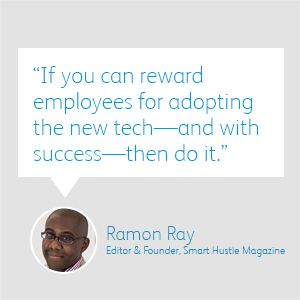(This post originally appeared on Small Business Solutions. We’re republishing the information for our enterprise audience because organizations of all sizes struggle with change management.)
By Ramon Ray, editor and founder, Smart Hustle Magazine
There is always a lot of talk about disrupting the customer experience, but what about disrupting the employee experience? You rely on high productivity levels and efficiency to keep your company running lean and mean. You also rely on high-quality equipment to do the same. But what happens when the two don’t jive?
Introducing any new technology—hardware or software—can cause significant disruptions to your work environment. These disruptions may be due to:
- A learning curve
- Employees resisting new technology
- A lack of time to train on it
- A general discontent with the decision to use said technology
Regardless of the why, what you need to focus on is the what: What do you need to do to help your team seamlessly transition to this new technology and welcome the change?
To start, you will need a new technology transition plan.
Building a New Technology Transition Plan in 10 Steps
You want everyone to embrace your company’s goals, which means they need to support any changes you introduce to the environment. You came to those decisions with great care, and this new technology is aimed at helping to propel your team and the company’s livelihood forward. Now it is time to figure out how to make everything work together, and not cause any major interruptions as the transition takes place.
- Consider the costs.
Before you invest in new technology, think about what the transition will entail regarding implementation, training, phasing out old technology, and so on. There should be no surprises on your end or your employees’ once the transition begins.
- Stay within the budget.
You likely set a budget for every new addition you make to your operations. For technology transitions, it will be especially important. If your new technology solution stresses you out or starts to feel like a burden, your employees will sense it and respond in kind.
- Be honest with your team.
Before any implementation of new technology, be upfront with your employees regarding the pros and cons. Yes, it may take them time to adjust, but it will also save them from a particularly time-consuming manual task they all abhor.
- Test it out.
Before you add new technology to your workflow, test it out yourself. If you are going to sell your employees on the value of it, you should have first-hand experience as a user and the #1 fan.
- Designate a spokesperson from each team.
Mob mentality can have a huge effect on how the acceptance or rejection of new tech goes down. As you work on testing it out yourself, find “spokespeople” from each team who can try it out and speak to the merits of it to the people who report to them.
- Provide hands-on training.
Documentation of a new piece of equipment or software is great, but it will not be as helpful or valuable as giving your employees the chance to learn how to use it through guided training sessions.
- Include the supplier in the conversation.
Employees may still fear that you are supportive of this new technology because it helps your bottom line, but won’t improve their situation. That is why it can be helpful to have the supplier come in to answer their questions and put their minds at ease.
- Create workarounds.
The hope is that implementation will go smoothly and there will be no disastrous gaps left between the old and new. However, it is a good idea to be prepared with workarounds in the case something should fall through the cracks.
- Launch when it is right for your employees.
By now you have a good idea of how the ebb and flow of your business works. If you want your employees to have the time and energy to truly focus on what you are showing them, plan to launch the new technology during a slow period.
- Don’t let anyone get left behind.
If there is resistance before the technology arrives, there will also be a reluctance to adopt it once it is here. Make sure that you enforce the use of it by not allowing people to make excuses and fall into old routines. If you can reward employees for adopting the new tech—and with success—then do it.
Remember: this is not about forcing new technology down your employees’ throats. It is about giving them a newer solution to do things better. And because you actually believe in this new technology to improve upon what you had before, it is your job to convince them to feel the same way. In many cases, new technology – especially when it’s intuitive and doesn’t require a lengthy learning curve – will actually make your workflows smoother and your employee’s jobs easier. That’s certainly the case with ConnectKey Technology® from Xerox.
All ConnectKey-enabled multifunction printers (MFPs) include a wealth of apps that do for the MFP what app technology did for your smart phone, transforming it from a simple scan, fax, copy device into a true workplace assistant that will allow you to automate workflows like billing and invoicing to make your office a happier, more productive place for everyone.


